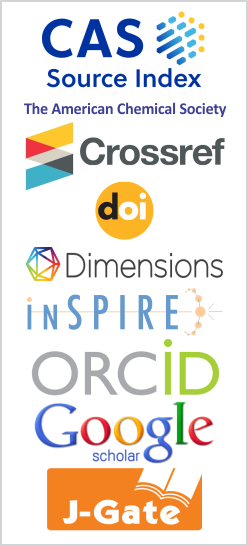Comparison of Electromagnetically Induced Transparency (EIT) Spectra for Six-level Lambda \((\Lambda)\) and Five-level V-type Systems
DOI:
https://doi.org/10.26713/jamcnp.v2i2.323Keywords:
42.50.Gy, 32.80.Bx, 32.70.-nAbstract
Electromagnetically induced transparency (EIT) is experimentally studied in a rubidium vapour cell (without buffer gas, both \(^{87}\)Rb and \(^{85}\)Rb present according to their natural abundance) kept within two-layers of \(\mu(\mu)\)-metal shields to avoid the effect of Earth's magnetic field on the energy levels of atomic rubidium. An external cavity diode laser (ECDL), used as a low power probe laser, is locked to the hyperfine cross-over peak of \(F = 2 \rightarrow F' = 2, 3\) transitions of \(^{87}\)Rb. The frequency of another ECDL, the pump laser, is set to scan the \(F=1 \rightarrow F' = 0, 1, 2\) transitions of \(^{87}\)Rb. These form the \(\Lambda\)-type six level system. In the V-type system, both the pump and the probe lasers share the same \(F = 2\) ground level. The probe beam coming out of the cell is detected by a low noise fast photodetector. The resulting spectra show signature of EIT in the "peak" for the \(\Lambda\)-type system and in the "dip" for the V-type system. Numerical calculation based simulated spectra are also compared with the experimental spectra. In both the cases very narrow EIT linewidth \((\Gamma_{t} < \Gamma)\) is observed even at high value of pump Rabi-frequency \((\Omega_{c}\gg \Gamma)\). Narrower value of EIT linewidth is due to Doppler averaging phenomena.Downloads
References
G. Alzetta et al., Nuovo Cimento B,36 (1976), 5.
K. J. Boller, A. Imamoglu and S. E. Harris, Phys. Rev. Lett.,66 (1991), 2593.
S. E. Harris, Phys. Today, 50 (1997), 36.
J. G. Banacloche, Y-Q Li, S-Z Jin and Xiao, Phys. Rev. A, 51 (1995), 576.
D. Bhattacharyya, B. K. Dutta, B. Ray, and P. N. Ghosh, Chem. Phys. Lett.,389(2004),113.
D. Bhattacharyya, B. Ray and P. N. Ghosh, Phys. B: At Mol. Opt. Phys.,40 (2007),4061.
D. A. Smith and I. G. Hughes, Am. J. Phys,72 (2004),631.
H. J. Metcalf and P. van der Straten, Laser Cooling and Trapping (Berlin: Springer),1999.
Y. Rostovtsev, I. Protsenko, H. Lee and A. Javan, J. Mod. Opt., 49 (2002) 2501.
M. V. Pack, R. M. Camacho and J. C. Howell, Phys. Rev. A, 76 (2007) 013801.
S. Stenholm, "Foundations of Laser Spectroscopy” (John Willey, New York) 1983
M. O. Scully and M. S. Zubairy, "Quantum Optics” Cambridge University Press London 1997.
Downloads
Published
How to Cite
Issue
Section
License
Authors who publish with this journal agree to the following terms:- Authors retain copyright and grant the journal right of first publication with the work simultaneously licensed under a CCAL that allows others to share the work with an acknowledgement of the work's authorship and initial publication in this journal.
- Authors are able to enter into separate, additional contractual arrangements for the non-exclusive distribution of the journal's published version of the work (e.g., post it to an institutional repository or publish it in a book), with an acknowledgement of its initial publication in this journal.
- Authors are permitted and encouraged to post their work online (e.g., in institutional repositories or on their website) prior to and during the submission process, as it can lead to productive exchanges, as well as earlier and greater citation of published work.




